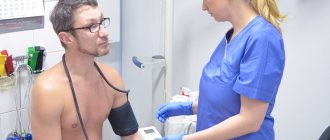High blood pressure (hypertension) is a problem for many people. It does not depend on the gender and age of a person. If hypertension is not treated, it threatens the body with serious complications. At the same time, it is much more difficult and longer to treat than a common cold. The patient is required to strictly follow all the doctor’s recommendations: only after this a positive treatment outcome is possible. Which doctor treats high blood pressure, how to recognize the symptoms of hypertension and when to make an appointment will be discussed in this article.
Types and symptoms of hypertension
Frequent cases of high blood pressure lead to the fact that this condition becomes habitual for the body. In a healthy person, blood pressure should be 120/80 mm. Hg Art. These values are determined by your heart rate. For various reasons, the internal diameter of blood vessels decreases, which creates obstacles for the passage of blood. The cross-sectional area becomes smaller, and the volume and speed of blood in the vessels remain constant.
Everything significantly increases blood pressure in the vessels. The walls of blood vessels wear out, and the heart begins to require more energy to pump blood. Depending on the pressure and the degree of “wear” of the vessels, three types of hypertension are distinguished:
- Light form. Characterized by an increase in blood pressure to 160/100. However, these abnormalities are not permanent and go away quickly without medication.
- Medium shape. High blood pressure lasts for quite a long time and reaches values of 180/110. In rare cases, normalization occurs without the help of medications.
- Severe form. Blood pressure is consistently high (180/110), taking medications helps little.
High blood pressure can be caused by various factors. Hereditary predisposition plays a large role in this. However, good genetics does not guarantee perfect health for anyone. Hypertension can also occur for other reasons:
- Excessive salt intake and high blood sugar;
- Increased blood cholesterol levels;
- Excess weight and poor diet (foods high in fatty acids are especially dangerous);
- Smoking and alcohol;
- Sedentary lifestyle, physical inactivity, lack of physical activity;
- Old age: the “risk group” includes people over 50 years of age.
Frequent cases of increased blood pressure (even if it later returns to normal) are a reason to contact a specialist. If you have high blood pressure, your doctor will provide first aid and prescribe a course of treatment. Patients themselves should know the symptoms of hypertension in order to make an appointment on time:
- Pain in the heart area;
- Shortness of breath and fatigue;
- Hoarse cough;
- Severe headaches, usually in the back of the head;
- Dizziness and nausea;
- Fear, panic and stress.
Mild forms of hypertension can be asymptomatic: a person simply does not notice that his blood pressure has increased. A sharp increase in pressure with the above symptoms occurs during a hypertensive crisis. If you notice these problems, you should immediately consult a doctor.
Causes of development of vascular diseases
The main vascular disease is atherosclerosis. Against this background, ischemic stroke, ischemic heart disease, obliterating endarteritis and other vascular pathologies often progress. Atherosclerosis is based on arterial damage caused by the accumulation of lipids and the proliferation of endothelial walls. The pathological process involves the arteries of the brain, heart, limbs, and neck. The main causes of vascular damage in the body:
- a high content of animal fats in the diet provokes atherosclerotic changes in blood vessels;
- smoking negatively affects the vascular walls, causes their spasm, and several times increases the risk of developing arterial hypertension and coronary heart disease;
- constant overload of the legs, wearing uncomfortable shoes lead to the development of varicose veins and other vein pathologies;
- frequent infectious diseases are accompanied by intoxication and damage to the vascular walls;
- excess weight is accompanied by impaired fat metabolism and is often a provoking factor in the development of varicose veins, atherosclerosis of the blood vessels of the brain and heart.
The risk of thrombosis and bleeding increases with superficial and internal hemangiomas. These vascular tumors most often undergo reversal, but may begin to actively grow, requiring surgical intervention. Hemangiomas arise mainly due to a failure in the formation of blood vessels at the stage of embryonic development.
Only a qualified specialist can establish the exact causes of vascular pathologies, using extensive diagnostic capabilities. To clarify the diagnosis and assess damage to the vascular system, various studies are prescribed: angiography, MRI, EchoEG, computed tomography, Dopplerography.
Help from specialists
A physician is a doctor who treats high blood pressure in its early stages. The therapist is a general practitioner, so in all cases of deterioration of health you should contact him. He will conduct an initial examination of the patient, take tests and, if necessary, refer him to a doctor of a more narrow specialization. The first thing the therapist does is measure blood pressure and pulse. Then he gets acquainted with the patient’s medical record and finds out other features of his life and health.
The key to successful diagnosis and treatment lies in collecting as much information as possible. The therapist needs to know everything: whether the patient has chronic diseases, what he was sick with before, whether he had injuries, surgeries, etc. Hereditary predisposition to hypertension is determined by asking about the health of relatives. Additionally, the therapist prescribes a number of tests and other measures:
- General and special blood tests, including hormone tests to assess the functioning of internal organs;
- Ultrasound of the heart and other organs if necessary;
- General urine analysis;
- Electrocardiogram (ECG);
- Examination of eye vessels;
- Examination of veins in the legs.
After these procedures, the therapist writes out referrals to other specialists. Among them are a cardiologist, neurologist, endocrinologist and other doctors. A cardiologist specializes in diseases of the cardiovascular system, so it is understandable that this doctor also treats high blood pressure. If hypertension is caused by disorders of the thyroid gland, the patient is sent to an endocrinologist.
Increased intracranial pressure indicates that the patient should be referred to a neurologist. If you are overweight, a nutritionist can best help: adjusting your diet brings your blood pressure back to normal without taking medications. Problems with the kidneys and other organs of the genitourinary system that cause hypertension are treated by a nephrologist. But most often, treatment is complex from several doctors, since all organs and systems of the body greatly influence each other’s work.
Diagnostics
The first step in diagnosing hypertension is to take several blood pressure measurements and analyze the medical history.
The second stage - laboratory and instrumental - includes:
- general urine analysis;
- general blood analysis;
- ECG;
- Ultrasound of the heart;
- Ultrasound of other organs (kidneys, adrenal glands, blood vessels);
- examination of the condition of the fundus by an ophthalmologist.
Assessment of overall cardiovascular risk
During the examination of patients with arterial hypertension, it is necessary to assess existing risk factors, identify concomitant clinical conditions and determine the degree of target organ damage. This stage of working with the patient is the most important, as it determines the treatment strategy. The amount of treatment that should be prescribed to a patient must correspond to the risk group to which the patient belongs. To determine the risk group for developing cardiovascular complications, risk stratification criteria are used.
In accordance with these criteria, all patients with arterial hypertension can be classified into one of four risk groups for developing cardiovascular accidents. Such differentiation into risk groups is necessary to select the optimal tactics for managing patients with arterial hypertension and measures to prevent further complications. These factors and your risk level can be determined after consulting a cardiologist.
Treatment of hypertension
Mild forms of hypertension are easy to treat. It is enough to make changes to your own diet and choose the right physical activity. In most cases, changing your lifestyle helps get rid of periodic increases in blood pressure. It is also mandatory to give up bad habits if the patient had them. If these methods do not help, the doctor treats high blood pressure with medications.
Medicines can be prescribed for a long period (sometimes for life) or individually to determine the body's response to a particular substance. It may happen that the initially proposed course of treatment also does not help. Then the patient should consult a doctor so that, if possible, he increases the dosage of the drug or prescribes other medications. The drugs can be taken individually or in combination.
In severe cases, the patient is hospitalized. Reasons for hospitalization: severe hypertensive crisis, suspicion of other heart diseases and sudden jumps in blood pressure. After providing emergency care and stabilizing the pressure, the patient is transferred to outpatient treatment. To restore the body, recovered people are recommended to go to a sanatorium or vacation.
When treating high blood pressure, it is necessary to treat concomitant diseases of other organs. In some cases they are the causes of hypertension, in others they are its consequences. It is best to treat them simultaneously with hypertension. Doctors prescribe a comprehensive course of therapy, which is not limited to taking medications. Physiotherapy and rehabilitation procedures are mandatory stages in the treatment of high blood pressure.
Hypertension is a serious disease that requires proper treatment. If you don't pay attention to your body's signals, high blood pressure can lead to much more serious consequences than just fatigue and shortness of breath. Trust your health to professionals. A doctor from the Rossimed clinic will help you cope with high blood pressure. Make an appointment with us and undergo high-quality diagnostics using new medical equipment.
How do vascular diseases manifest themselves?
Clinical manifestations of vascular diseases depend on the location of the pathological area and the degree of its damage. At the initial stage, the disease often occurs without pronounced symptoms, but with regular preventive examinations and laboratory diagnostics, which reveal high cholesterol levels, you can promptly suspect the occurrence of a disorder and seek medical help.
When the blood vessels of the brain are damaged, the following symptoms occur:
- decreased memory and attention;
- dizziness;
- low performance;
- worsening sleep;
- noise in ears.
The development of atherosclerosis of the vessels of the extremities is accompanied by the following changes:
- chilliness of the limbs;
- numbness of the legs;
- pain in the calf muscles, which intensifies while walking;
- pale skin on the legs, tendency to peeling and the formation of trophic ulcers.
Atherosclerosis of the coronary vessels has characteristic manifestations:
- chest pain;
- lack of air;
- fear of death;
- fluctuations in pulse and blood pressure.
Medical intervention if any of the described symptoms appears is mandatory. The doctor prescribes treatment after receiving the results of the examination and examination, assessing the general condition of the patient’s body.
4. Other examination results for arterial hypertension
During the appointment, the doctor can check whether high blood pressure has caused damage to other organs - blood vessels, heart or eyes. Unusual heart sounds when listening, swollen neck veins (this may indicate heart failure), swelling of the arms and legs, and vascular abnormalities in the back of the eye can indicate various health problems. This means that additional examinations may be necessary.
What should you think about?
The diagnosis of hypertension, or high blood pressure, is usually made based on the average of two or more readings obtained during two or more doctor visits. But in very severe cases, one visit is enough. Self-measurement of blood pressure can also help in diagnosis. Some people are nervous before visiting the doctor, and their blood pressure rises. This means that the picture may not be entirely objective. But if you measure your blood pressure at home and then report the data to your doctor, it can be very helpful in accurately diagnosing hypertension.











